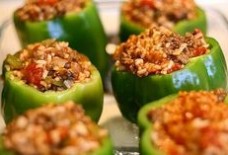Lebanese Apricot Jam: A Summer Delight to Savor this Winter
They barely arrived intact at my house—the box of delicate and divine Blenheim apricots my sister in the Santa Clara valley of Northern California was generous to send me from her backyard tree. This valley’s perfect growing climate for this variety used to have apricot orchards galore, until it became more lucrative to create housing galore for Silicon Valley. The fruit of this tree is incomparable for making our traditional Lebanese apricot jam, and it is now a rare fruit in the marketplace due to its fragility and delicacy. No other apricot surpasses it in flavor, though the new varieties ship and store well, and even have a rosy appearance—nothing has the flavor of this treasured variety, also called Royal Blenheims.
My immigrant parents planted an apricot tree in our Los Angeles back yard—and making apricot jam was an awaited summer ritual. I remember my grandmother sitting on the back door steps with a hammer cracking open the rock-hard shell of the seed to release the precious apricot kernel held within—a crunchy, flavorful, and nutritious addition to the traditional recipe. As a child, I didn’t know the trick to cracking the hard shell, and remember hitting my fingers with the hammer a few too many times, and crushing the kernels too. Not good. Read on for the secret to cracking them open.
How it is made: fresh, ripe apricots are washed, pitted, and put into a big enamel pot on the stove top; a modest amount of sugar is poured on top without mixing until the next day. I used 2 cups of sugar to about 6 cups of apricots. Overnight the sugar penetrates the apricots, and has begun to create a syrup in the bottom of the pot. The next morning, stir the mixture and begin cooking over a slow heat. Simmer them for a couple of hours and in the meantime, wash and dry the seeds or pits so they’re not slippery, and crack them open with a hammer to extract the kernel. The trick to this is to hold them with the grooves pointing upward between your thumb and index finger, and with one, well-placed hit on top, they split easily and effortlessly!
The kernels are parboiled for about 10 minutes to remove bitterness and facilitate slipping off the skins. Then plunge them into cold water and slip off the skins. These nuts are added to the cooking apricots and the jam continues to simmer until it has thickened. At the very last minute of cooking, the juice of a couple of fresh lemons is added to the jam as a preservative and flavor enhancer. The full recipe for our Lebanese jam as my grandmother and mother made it can be found in Alice’s Kitchen: Traditional Lebanese Cooking on page 15.
Here in the Pacific Northwest, the climate is not right for growing Royal Blenheims, so the advice I received from an organic produce supplier is to try a variety of apricots called Robado, which are now available organically in stores like New Seasons in the Portland area. A number of years ago, a dear artist friend who now lives in Italy, brought me a box of apricots from her tree in Yakima, Washington that were delicious. The secret to fabulous apricot jam is in finding the tastiest apricots available. Now is the time to hunt them down at farmers’ markets, Hood River, and Eastern Oregon and Washington. Don’t judge by appearances, which can be deceiving—do the taste test before you buy a lug of them.
The fruit my sister sent me was mailed over the weekend, and with the California heat they were practically fermented when they arrived. Of course, I made jam with the soft, juicy ones that had already split open, and started making apricot liqueur with the intact fruit that already began to taste spirituous. I hope you enjoy the short season of this ambrosial summer delight, and if you can avoid tasting the jam by the spoonful every time you’re in the kitchen like I did, you’ll have enough to can and save for winter—and you’ll be happy you did!
—Linda Dalal Sawaya is a Portland artist, cook, Master Gardener, and author of Alice’s Kitchen: Traditional Lebanese Cooking
Remember, as my mother Alice said, “If you make it with love, it will be delicious!”
all photos and story © linda dalal sawaya 2015
Source: www.golocalpdx.com


